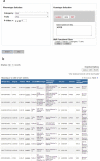GRASP v2.0: an update on the Genome-Wide Repository of Associations between SNPs and phenotypes
- PMID: 25428361
- PMCID: PMC4383982
- DOI: 10.1093/nar/gku1202
GRASP v2.0: an update on the Genome-Wide Repository of Associations between SNPs and phenotypes
Abstract
Here, we present an update on the Genome-Wide Repository of Associations between SNPs and Phenotypes (GRASP) database version 2.0 (http://apps.nhlbi.nih.gov/Grasp/Overview.aspx). GRASP is a centralized repository of publically available genome-wide association study (GWAS) results. GRASP v2.0 contains ∼ 8.87 million SNP associations reported in 2082 studies, an increase of ∼ 2.59 million SNP associations (41.4% increase) and 693 studies (48.9% increase) from our previous version. Our goal in developing and maintaining GRASP is to provide a user-friendly means for diverse sets of researchers to query reported SNP associations (P ≤ 0.05) with human traits, including methylation and expression quantitative trait loci (QTL) studies. Therefore, in addition to making the full database available for download, we developed a user-friendly web interface that allows for direct querying of GRASP. We provide details on the use of this web interface and what information may be gleaned from using this interactive option. Additionally, we describe potential uses of GRASP and how the scientific community may benefit from the convenient availability of all SNP association results from GWAS (P ≤ 0.05). We plan to continue updating GRASP with newly published GWAS and increased annotation depth.
Published by Oxford University Press on behalf of Nucleic Acids Research 2014. This work is written by US Government employees and is in the public domain in the US.
Figures
References
Publication types
MeSH terms
Grants and funding
LinkOut - more resources
Full Text Sources
Other Literature Sources


